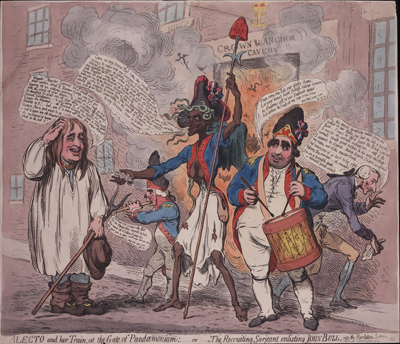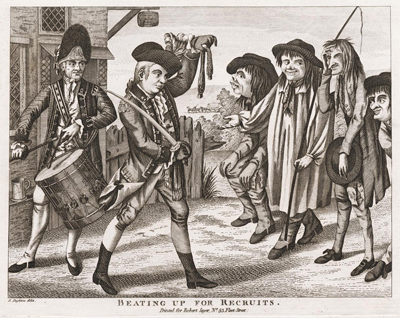Alecto and her Train, at the Gate of Pandaemonium...
Alecto and her Train... is one of three prints by Gillray inspired by the second anniversary celebration of the fall of the Bastille. The others include The Hopes of the Party Prior to July 14th and A Birmingham Toast, as Given on the 14th of July by the Revolution Society.
In Alecto and her Train..., we see Alecto, the fury known to readers of Vergil's Aeneid as a sower of discord and division, posing as a recruiting sergeant with Charles James Fox and Richard Brinsley Sheridan supporting her on drum and fife. Alecto is portrayed as a sans-culotte and revolutionary with a tri-color cockade on her hat and a bonnet rouge atop her pike. Standing before the Crown and Anchor Tavern, now seen as the mouth of Milton's Hell in Paradise Lost, she offers incentives in the form of French assignats to the country yokel, John Bull, to "enter into my Company of Gentlemen Volunteers [like Fox and Sheridan] enlisted in the cause of Liberty."
Significantly, Gillray does not serve up pure governmental propaganda. John Bull neither accepts nor rejects enlistment. Instead he scratches his head, and says "Ah me! I dozes'nt know what to do, not I!" As suggested by John Bull's placement to the side and the centrality of Alecto, Gillray's focus is not on John Bull's decision but rather on the emerging discord created by the polarization of attitudes towards the Revolution.

© Lewis Walpole Library, Yale University
In ten days time (July 14th), the Crown and Anchor would host nearly a thousand Whigs celebrating the second anniversary of the fall of the Bastille. Like Gillray, both Whigs and Tories anticipated that strife and further division might result from the celebration. Though he presided over the first anniversary celebration in 1790, Earl Stanhope is likely to have been warned by his brother-in-law to stay away as Gillray suggests by including a letter in his hand "To Lord Stanhop[e] from W. Pitt" as he slinks away. As it turned out none of the most prominent Whigs attended the London celebration, and the festivities were curtailed to avoid a confrontation. But in Birmingham where a similar celebration was held, the meeting DID result in full-scale pandemonium, including the looting and burning of houses belonging to revolutionary sympathizers. See my commentary on A Birmingham Toast. . ..
Recruiting officers had been a recognizable sight in Britain since at least 1706 when the popular play, The Recruiting Officer by George Farquhar was first staged. Indeed the practice of "beating up" for recruits would have been familiar to Gillray and his audience from numerous prints, several plays, and everyday experience. Officers would typically target taverns and fairs where men could be found in numbers and plied with liquor and monetary incentives as shown in the Robert Dighton print below. The dress of the lank-haired yokel and his head scratching friend makes me wonder whether Gillray might have seen and in fact remembered this print. In any case, Gillray, as he often does, uses a familiar image to argue that continued Whig sympathy for the revolution is tantamount to recruiting volunteers for France and, in so doing, creating the real problem—internal strife within Britain.

Beating Up For Recuits [ca. 1780?]
© Lewis Walpole LIbrary, Yale University
Sources and Reading
- Commentary from the British Museum on Alecto and her Train, at the Gate of Pandaemonium....
- "Alecto," Wikipedia
- "Pandaemonium (Paradise Lost," Wikipedia
- Crown & Anchor Tavern, Strand
- Thomas Wright and R.H. Evans, Historical and Descriptive Account of the Caricatures of James Gillray #56.
- Thomas Wright and Joseph Grego, The Works of James Gillray, the Caricaturist; With the History of His Life and Times, p. 130
Comments & Corrections
NOTE: Comments and/or corrections are always appreciated. To make that easier, I have included a form below that you can use. I promise never to share any of the info provided without your express permission.